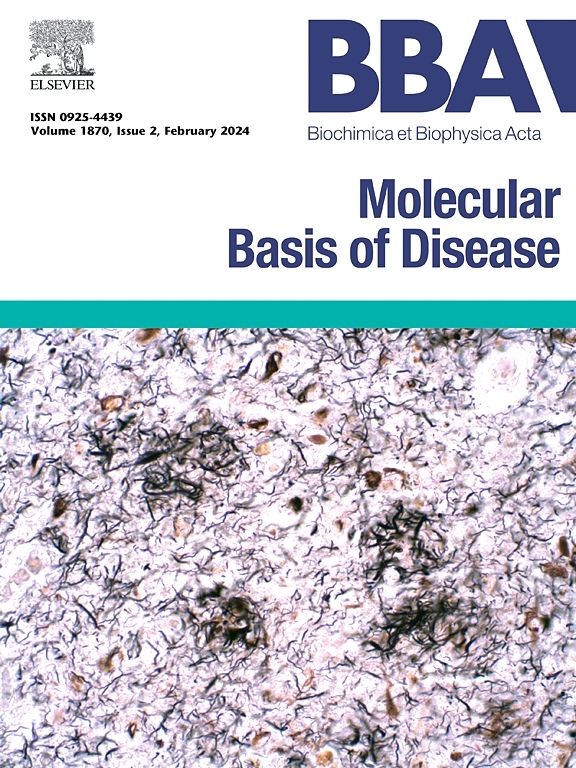Angiogenesis and immune microenvironment in triple-negative breast cancer: Targeted therapy
IF 4.2
2区 生物学
Q2 BIOCHEMISTRY & MOLECULAR BIOLOGY
Biochimica et biophysica acta. Molecular basis of disease
Pub Date : 2025-04-30
DOI:10.1016/j.bbadis.2025.167880
引用次数: 0
Abstract
Triple-negative breast cancer (TNBC) is a highly aggressive breast cancer subtype that typically lacks effective targeted therapies, leading to limited treatment options. Chemotherapy remains the primary treatment modality; however, in recent years, new immunotherapy approaches, such as immune checkpoint inhibitors, have shown positive results in some patients. Although the development of TNBC is closely associated with BRCA gene mutations, the tumor immune microenvironment (TIME) plays a crucial role in tumor progression and immune escape. Tumor angiogenesis, the accumulation of immunosuppressive cells, and alterations in immune molecules collectively shape an environment unfavorable for anti-tumor immune responses. Tumor-associated macrophages (TAMs) and myeloid-derived suppressor cells (MDSCs) promote immune escape by secreting immunosuppressive factors. Therefore, combination strategies of anti-angiogenic and immune checkpoint inhibitory therapies have shown synergistic effects in clinical trials, while new targeted therapies such as TGF-β inhibitors and IL-1β inhibitors offer new options for TNBC treatment. With the development of personalized medicine, combining immunotherapy and targeted therapies brings new hope for TNBC patients.
血管生成和免疫微环境在三阴性乳腺癌:靶向治疗
三阴性乳腺癌(TNBC)是一种高度侵袭性的乳腺癌亚型,通常缺乏有效的靶向治疗,导致治疗选择有限。化疗仍然是主要的治疗方式;然而,近年来,新的免疫治疗方法,如免疫检查点抑制剂,在一些患者中显示出积极的结果。虽然TNBC的发生与BRCA基因突变密切相关,但肿瘤免疫微环境(tumor immune microenvironment, TIME)在肿瘤进展和免疫逃逸中起着至关重要的作用。肿瘤血管生成、免疫抑制细胞的积累和免疫分子的改变共同形成了不利于抗肿瘤免疫反应的环境。肿瘤相关巨噬细胞(tam)和髓源性抑制细胞(MDSCs)通过分泌免疫抑制因子促进免疫逃逸。因此,抗血管生成和免疫检查点抑制联合治疗策略在临床试验中显示出协同效应,而TGF-β抑制剂和IL-1β抑制剂等新的靶向治疗为TNBC治疗提供了新的选择。随着个性化医疗的发展,免疫治疗与靶向治疗相结合为TNBC患者带来了新的希望。
本文章由计算机程序翻译,如有差异,请以英文原文为准。
求助全文
约1分钟内获得全文
求助全文
来源期刊
CiteScore
12.30
自引率
0.00%
发文量
218
审稿时长
32 days
期刊介绍:
BBA Molecular Basis of Disease addresses the biochemistry and molecular genetics of disease processes and models of human disease. This journal covers aspects of aging, cancer, metabolic-, neurological-, and immunological-based disease. Manuscripts focused on using animal models to elucidate biochemical and mechanistic insight in each of these conditions, are particularly encouraged. Manuscripts should emphasize the underlying mechanisms of disease pathways and provide novel contributions to the understanding and/or treatment of these disorders. Highly descriptive and method development submissions may be declined without full review. The submission of uninvited reviews to BBA - Molecular Basis of Disease is strongly discouraged, and any such uninvited review should be accompanied by a coverletter outlining the compelling reasons why the review should be considered.

 求助内容:
求助内容: 应助结果提醒方式:
应助结果提醒方式:


